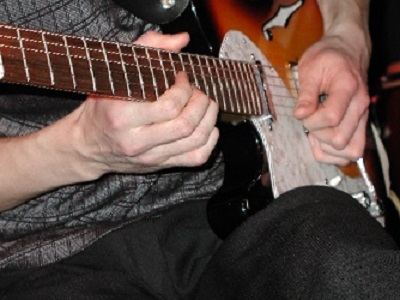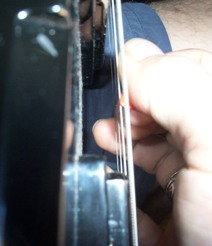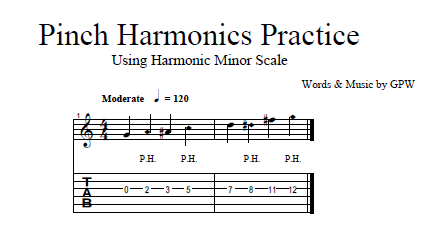How to Play Artificial And Pinch Harmonics
 In the previous lesson, we taught you how to play natural harmonics on the guitar. Today’s lesson on artificial harmonics is actually a very closely related technique.
In the previous lesson, we taught you how to play natural harmonics on the guitar. Today’s lesson on artificial harmonics is actually a very closely related technique.
What makes artificial harmonics different from natural harmonics, is that the fundamental tones of natural harmonics are always played as open strings, while artificial harmonics have fretted notes as their fundamental tones.
When you play harmonics on a guitar, or other stringed instrument, what you are doing, is accentuating certain overtones of a note. The fretted note forms the dominant part of the note, known as the fundamental tone, while the other tones are known as overtones. Together, all these tones form the note and give it its characteristic timbre.
This is why playing the same note on different positions on a guitar, produces subtle differences. Compare an open A on the fifth string, to the same A, played on the 5th fret of the sixth string. The open A is slightly richer, mainly because the string is longer (in comparison to the fretted fifth string) so there are more overtones present.
What Are Artificial Harmonics?
Artificial harmonics can be played on acoustic/classical or electric guitars. With the acoustic guitars, the artificial harmonics create a pleasant “harp-like” sound. Electric guitars allow you to boost the gain and volume and to really crank out sounds from nodal points that normally would be too subtle to notice.
Anyways, the same principles that apply to finding natural harmonics also apply to locating and playing artificial harmonics. To illustrate this, let’s use the fifth string of the guitar as an example.
Now, your natural harmonics will be on the 12th, 5th and 7th frets, as well as the 24th. When the string is open, your fundamental tone is A. If you change the fundamental tone to the 2nd fret, it becomes B.
The harmonic nodes for the 2nd fret B on the 5th string, are found on the 14th, 7th and 9th frets. When you play artificial harmonics, the notes are sounded just above the frets, not to the left of them, as you would normally fret a note.
A Quick Overview of Artificial Harmonics on Guitar
- Are produced with a right hand technique
- Are fretted
- Are easy to produce anywhere on the neck once you master your right hand technique
- Can be played with several different techniques
- Are indicated in tablature with a ‘AH’ above the note for artificial harmonics
I’m Not An Octopus! How Do I Play Artificial Harmonics?
If this is the first time you are experimenting with artificial harmonics, you will probably encounter the challenge of playing the actual notes. You see, your left hand is usually too far down the fretboard of the guitar, where you are fretting the new fundamental tone, to sound the harmonic node point.
To sound out the artificial harmonics, you need to strike the string as close to the bridge as possible, while still being able to reach the desired node point with your index finger on your right hand. If you are using a pick, you strike the string with the pick resting between your thumb and middle finger, while the index finger is extended to the node point. If you use a thumb pick, it is a bit easier, and gives you more flexibility and reach.
Artificial Harmonics With The Fingerpicking Technique
Hold down a note with your left hand, and use the index finger of your right hand to create the same ‘soft touch’ that your left hand uses to create an open-string harmonic. Use your other fingers or a pick to play the note.
As with playing natural harmonics, this is difficult to do quickly because of application into songs. That’s why the use of artificial harmonics in practical playing is really limited and you don’t see many people doing it.
That’s why I’m going to introduce the concept of pinch harmonics in the 2nd half of this lesson. They are a quicker and smoother way to incorporate artificial harmonics into your playing.
The Pinch Harmonic Technique
First of all, be sure that your picking technique is correct, your posture is good, and you have plenty of practice playing with different techniques.
With other types of harmonics, the touching finger and plucking finger are different. With pinch harmonics, the thumb does both the ‘soft touch’ and picking work.
How to Play a Pinch Harmonic
Step 1: Hold the pick so that it is only just poking out from the bottom of your thumb.
Step 2: Hold down a note with your left hand
Step 3: Place your right hand halfway between the fretted note and the bridge
Step 4: Hit the string with the pick, and immediately after the note is struck, use your thumb to softly touch the string to produce the harmonic.

A Variation of the Pinch Harmonic – The Double Attack Technique
The double attack technique of playing harmonics is credited to JK Hays, a guitarist from Stidham Hays. It produces a clear, sweet-sounding harmonic.
To play a double attack harmonic:
- Hold down a note with your left hand
- Hold the pick as you normally would, with your right index finger
- Hold your hand over the node that you want to use to create a harmonic (halfway, a third of the way, a quarter of the way, or a fifth of the way between the fretted note and the bridge)
- Pluck the string with your right hand middle finger, and then touch the pick to the string lightly to create a harmonic.
Exercise to Practice Your Harmonics

Download .gtp5 ( Right-click Save Target as… )
This exercise is all about control and the ability to play pinch harmonics at will. One note is played normally while the alternate note is played with pinch harmonics.
Instructions For Every Guitar Style And Level of Playing Imaginable

Jamplay is the GREATEST online guitar lesson resource that offers step-by-step videos in HD. They cover ALL genres of guitar styles and have exhaustive content for guitar players of any skill level.
Jamplay also features a growing collection of instructional videos that is updated each week. Furthermore, they also offer detailed tutorials for members to learn well known songs with the help of accurate, interactive tablatures and song visualizations.
p.s: We have created a special deal for our readers. Get your exclusive Jamplay promotional code here…






Leave A Comment